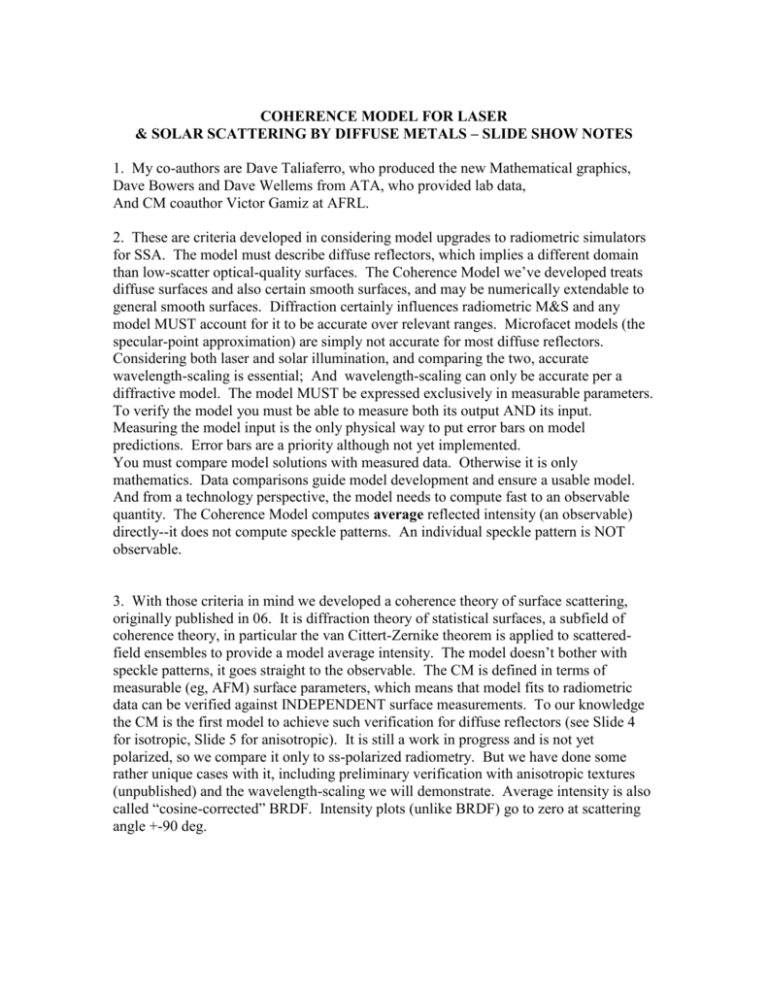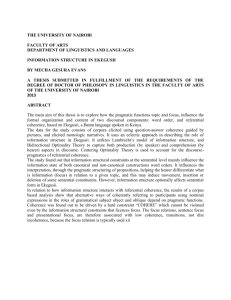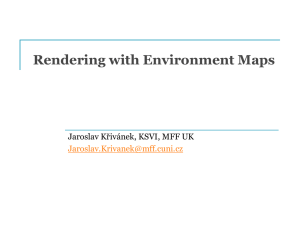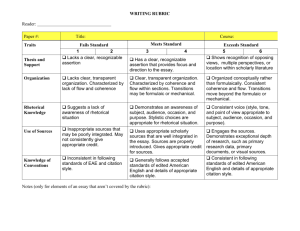Slide notes - EPNER TECHNOLOGY INC.
advertisement

COHERENCE MODEL FOR LASER & SOLAR SCATTERING BY DIFFUSE METALS – SLIDE SHOW NOTES 1. My co-authors are Dave Taliaferro, who produced the new Mathematical graphics, Dave Bowers and Dave Wellems from ATA, who provided lab data, And CM coauthor Victor Gamiz at AFRL. 2. These are criteria developed in considering model upgrades to radiometric simulators for SSA. The model must describe diffuse reflectors, which implies a different domain than low-scatter optical-quality surfaces. The Coherence Model we’ve developed treats diffuse surfaces and also certain smooth surfaces, and may be numerically extendable to general smooth surfaces. Diffraction certainly influences radiometric M&S and any model MUST account for it to be accurate over relevant ranges. Microfacet models (the specular-point approximation) are simply not accurate for most diffuse reflectors. Considering both laser and solar illumination, and comparing the two, accurate wavelength-scaling is essential; And wavelength-scaling can only be accurate per a diffractive model. The model MUST be expressed exclusively in measurable parameters. To verify the model you must be able to measure both its output AND its input. Measuring the model input is the only physical way to put error bars on model predictions. Error bars are a priority although not yet implemented. You must compare model solutions with measured data. Otherwise it is only mathematics. Data comparisons guide model development and ensure a usable model. And from a technology perspective, the model needs to compute fast to an observable quantity. The Coherence Model computes average reflected intensity (an observable) directly--it does not compute speckle patterns. An individual speckle pattern is NOT observable. 3. With those criteria in mind we developed a coherence theory of surface scattering, originally published in 06. It is diffraction theory of statistical surfaces, a subfield of coherence theory, in particular the van Cittert-Zernike theorem is applied to scatteredfield ensembles to provide a model average intensity. The model doesn’t bother with speckle patterns, it goes straight to the observable. The CM is defined in terms of measurable (eg, AFM) surface parameters, which means that model fits to radiometric data can be verified against INDEPENDENT surface measurements. To our knowledge the CM is the first model to achieve such verification for diffuse reflectors (see Slide 4 for isotropic, Slide 5 for anisotropic). It is still a work in progress and is not yet polarized, so we compare it only to ss-polarized radiometry. But we have done some rather unique cases with it, including preliminary verification with anisotropic textures (unpublished) and the wavelength-scaling we will demonstrate. Average intensity is also called “cosine-corrected” BRDF. Intensity plots (unlike BRDF) go to zero at scattering angle +-90 deg. 4. The CM has been able to model Epner diffuse gold rather well and we continue to use it as a development standard. This is a NIST-traceable gold coating used to calibrate IR radiometers. It is diffuse but much less so than a thermal or other Lambertian source. This result was published in Proc. SPIE in 2007. We measured the surface with AFM, at the AFRL/RDS OCEL, extracted the parameters for the Coherence Model (with more uncertainty than we’d like), and achieved this fit to near-monostatic laser BRDF measured independently (not by us) at AFRL/RDL. These exact same AFM surface parameters are maintained and provide good fits to spectral BRDF measurements of this surface made at a completely independent AFRL/RVS lab with a white-light scatterometer. 5. Since the rest of the briefing focuses on Epner diffuse Au, here we show the Coherence Model tested & verified for another diffuse metal: a satellite titanium with anisotropic finish. Here’s the anisotropic BRDF…this is on a log scale, so when you look at this reflectance function it’s almost appears as a line oriented normal to the surface striations. We used a 1D Coherence Model, based on AFM surface parameters, to predict reflectance along that line, and achieved a good fit at 633nm. Model surface parameters (sigma_h, rho1, rho2) for this fit are the exact parameters extracted from AFM data; no optimization was performed. This is the extrapolation to broadband as will be detailed for diffuse gold. 6. These are some applications—jump here to design, and this type of model can be useful in designing instruments and manufactured products with these diffuse metallic textures. The application we’re most recently tasked with is space-situational awareness (video). Trying to classify a space object with such little data, specifically without an image, requires very accurate radiometric models. 7. To model solar reflection the model must of course account for diffuse illumination, and should be applicable to sources even more diffuse than the Sun. Diffuse illumination is characterized by a narrow coherence function. The coherence model naturally incorporates diffuse illumination in that the reflected coherence function is the product of the coherence function that would result from laser/coherent illumination and the coherence function of the diffuse illumination. We treat the Sun as a thermal disk, following the treatment of Agarwal, Gbur, and Wolf. There are probably higher-order corrections for limb darkening, but according to this paper a uniform thermal disk is a good approximation. Looking at a schematic you can almost surmise that the effect of diffuse illumination is to convolve the laser BRDF with the angular spectrum of the source, and that is almost correct. However the geometrical approximation breaks down at large scattering angles. [Animate] In this notional convolution plot suppose the green curve is a diffuse laser BRDF and the blue pulse is the angular spectrum of a thermal disk source. 7. (continued) The problem for large convolution arguments is that this convolution does not go to zero at 90 degrees. This is where coherence theory saves you, or corrects the geometrical approximation, by specifying a non-geometrical convolution. [Animate] This is the (Van Cittert-Zernike) equation for average scattered intensity assumed by the Coherence Model. We’ve previously published analysis of the constraints imposed by coherence theory on the integrand of this equation. In particular, coherence theory requires that this cosine-squared factor be outside the integral. Other scattering models (eg, Beckmann and He-Torrance) keep this cosine-squared factor inside the integral, which makes the integrand a radiance function (depending on both position and direction) that doesn’t qualify as a coherence function. Now, under diffuse illumination the Coherence Model says that this integrand (mu) becomes the product of the coherence function under laser illumination and the coherence function of the diffuse illumination. Since the VCZ theorem is a Fourier transform relation, [animate] this integral becomes the convolution of the laser BRDF with the source angular spectrum, but, critically, this cosine-squared term is applied after the convolution, which ensures that the average intensity still goes to zero at 90 degrees. 8. It’s important to realize that 2D convolution is always required, even if the data to be modeled is one-dimensional, as is most measured data. The two-dimensional convolution differs from a 1D convolution, and affects any 1D slice of the fullhemisphere BRDF. This implies that the model must always compute the fullhemisphere BRDF to accurately model diffuse illumination. Here’s a flowchart of the non-geometrical convolution operation in Mathematica. First the laser BRDF is computed over the full scattered hemisphere. The cosine-squared factor is divided out per the Coherence Model, then the hemispherical function is converted into an image file. Convolution with the source angular spectrum is applied by high-level image-processing routines, then the cosine-squared factor is reapplied to produce the full-hemisphere diffuse BRDF. This example, which is not Epner diffuse gold but a more specular refelctor, gives the result for a source of variable angular subtense as annotated. 9. The Coherence Model scales with wavelength per diffraction theory. At this stage we’re comparing the model with perfect conductors, a good approximation to which is gold from above about 800nm wavelength. Here’s what the model predicts for the monostatic BRDF of Epner diffuse gold from 800nm to 10um, for laser illumination, and then convolved with the solar disk. Under solar illumination it’s slightly broader at longer wavelengths, with almost no change at shorter wavelengths. The effect is small because the surface is inherently diffuse. (In the limit of a Lambertian reflector there will be no effect). The effect of diffuse illumination will more pronounced for less diffuse reflectors. Then the animation shows the monostatic spectral BRDF as the illumination gets more diffuse. The laser and solar BRDFs are actually the first two frames of the animation. 10. Testing the model against a thermal diffuse source requires a thermal diffuse source, which was provided by the AFRL/RVSS SNOBAL scatterometer. 11. Here’s the reflectivity curve for Epner laser gold (from the Epner web site), which goes to 100% from around 800nm all the way out past 10um. This reflectivity is applied to CM solutions as a wavelength-dependent emittance factor. And here’s the spectrum of Epner diffuse gold measured at SNOBAL. The SNOBAL detector changes around 1450nm, which lowers SNR a bit, but the data is usable out to 1800-1900nm, above which normalization introduces a lot of noise. At shorter wavelengths the SNOBAL data appears usable all the way over the absorption edge, down to around 400nm. Since the current Coherence Model assumes a perfect conductor, we didn’t expect to see good fits below about 800nm wavelength, but as we will show, with only the emittance multiplier the model actually fits this data pretty well over the absorption edge down to around 600nm. 12. The other data source for model testing is atomic-force microscope (AFM) surface data. This data for Epner diffuse gold was taken with the Quesant AFM in the AFRL/RDS OCEL laboratory. The scan area is limited to 80x80um (looks like 50x50um in this case), which means low-frequency surface components may be undersampled, but for this texture on a flat coupon low frequencies are negligible. The surface parameters used by the Coherence Model are roughness sigma, and the first two derivatives of the surface autocorrelation function, rho_1 and rho_2, which are extracted from a polynomial fit to the computed surface autocorrelation. Higher derivatives are extracted as well (rho_3 is listed here), to ensure they are small compared to rho_1 or rho_2, as assumed by the autocorrelation series expansion inherent in the CM. There’s some variation among different scans of the same coupon (we’d like more AFM data to define error bars on the surface parameters), but this is generally a “well-behaved” texture in that low frequencies and higher-order derivatives are negligible. The extraction routine could be more robust in accounting for uncertainty in the autocorrelation in particular, but at this stage these parameters should be considered seed parameters for an optimization routine to achieve optimal fits to measured BRDF data. In fact, the surface parameters in this yellow column are used exactly as listed to achieve the fits shown in this briefing. 13. Data comparisons can be made within the range of validity of the model. Again, at this stage the Coherence Model predicts only ss-polarized reflectance. At this stage the model assumes perfect conductors, although the fits to diffuse gold at 600nm wavelength imply that this may not be a firm requirement. The model also does not yet incorporate shadowing, which occurs at bistatic angles if the surface roughness is deep like that of Epner diffuse gold. Shadowing is avoided at monostatic and small bistatic angles, so with the SNOBAL scatterometer we use a 10degree bistatic configuration as drawn here. The first SNOBAL data point is at AOI=10 degrees and scatter angle = 0 relative to the surface normal. [Click for animation] Then AOI=5 and scatter angle = 5, in the specular direction, then AOI = 0, and so on. 14. To extract 1D data we produce the appropriate grid of model full-hemisphere solutions. Here the grid covers the wavelengths and AOIs sampled in the SNOBAL data. This BRDF changes slowly, but you can see it shifts with AOI and narrows slightly with wavelength. Recall the full-hemisphere models are needed for 2D convolutions to describe diffuse illumination, so there’s no way around generating these. To extract a 1D dataset (eg, most measured datasets), we extract one point from each full-hemisphere solution. That is the point where the receiver is located. [Click] Zooming in on these three AOI solutions, at a single wavelength, the SNOBAL 10-degree bistatic configuration is extracted as follows: These vertical lines mark 0degree scattering angle relative to the surface normal. The first SNOBAL data point is at 10-degree AOI and scatter angle theta_s = 0; [Click] At 5-degree AOI the scatter angle is also 5 degrees and is in the specular direction; [Click] At AOI = 0 the scatter angle is at 10 degrees; Then, as the AOI increases on the opposite side of the receiver, the scatter angle increases on the opposite side of the specular peak [Click] Back to AOI = 5, now theta_s = 15; [Click] AOI = 10, theta_s = 20, and so on. This is a standard extraction and rendering routine for the CM. To implement this rendering routine the model obviously must compute the hemispherical BRDFs quickly, which is another advantage of the CM over numerical and Monte-Carlo models. 15. Applying this extraction routine over the entire SNOBAL grid leads to good fits over the range 800-1800nm. Keep in mind this fit over the entire band was achieved without changing the model surface parameters from those used to fit the laser BRDF at 1064nm. Optimization of the surface parameters over the entire band will further improve the fit. 16. Here are slices at individual wavelengths, using broadband normalization. At this stage there’s been no optimization beyond the initial fit to laser monostatic BRDF at 1064nm using the raw AFM surface parameters. The fit at 600nm, where gold reflectivity is down around 90%, is even pretty good pending optimization. In fact, the fit at 400nm (not shown) is even promising pending optimization. 17. Here are the SNOBAL and CM surfaces side-by-side, and the squared-difference surface to be minimized in the optimization routine. We haven’t gotten to optimize over the entire band yet. 18. Finally, we can apply the CM to investigate the spectral invariance of this surface. We know the reflectivity of gold is constant over a wide IR band, but this is not just any gold surface. This surface is used as an IR calibration standard because the shape of the BRDF is constant with wavelength, which is a much stronger condition than constant total reflectivity. If we look at the wavelength-dependence of the Coherence Model for this surface, for a simple monostatic geometry, there are three factors that alone exhibit strong wavelength dependence: a positive exponential function, a harmonic function, and a complementary error function. For these factors to cancel each other’s wavelength dependence takes a very particular set of surface parameters, ie a very particular texture. So, this shows that the CM has a very detailed wavelength dependence that happens to be flat for this texture over this waveband. (We didn’t just set the wavelength to a constant to achieve the SNOBAL fits.) BTW, this “1” is the incoherent term, and this integral is due to coherence on the surface. [Click] The model could be optimized against spectral invariance as against the SNOBAL data. These are the 3 surface parameters to vary in the current model, and this animation shows the difference surface against the SNOBAL data as a single parameter (rho_2) varies. By this approach we could derive a spectrallyinvariant texture, possibly one even more invariant than the Epner texture. 19. None 20. None








